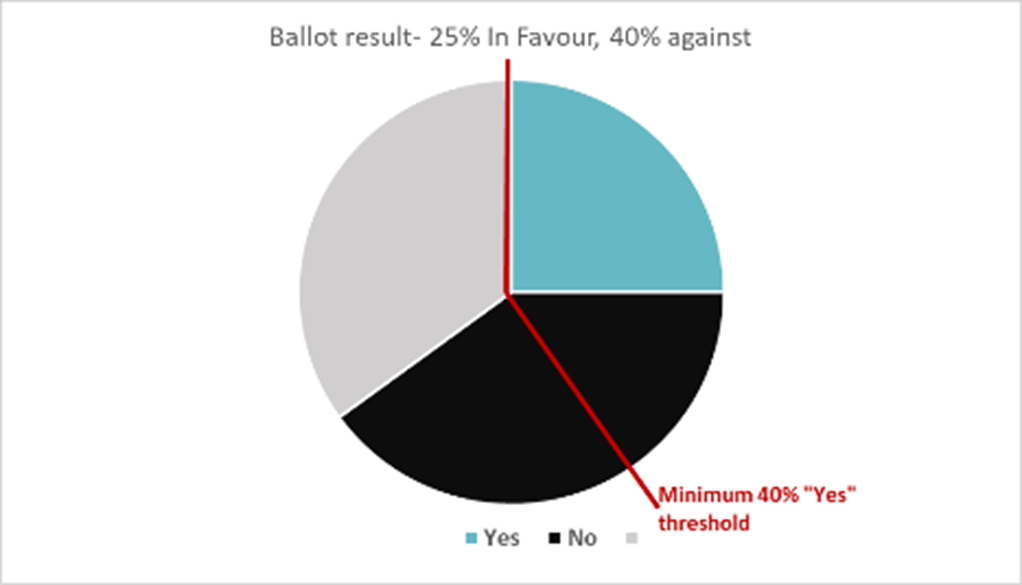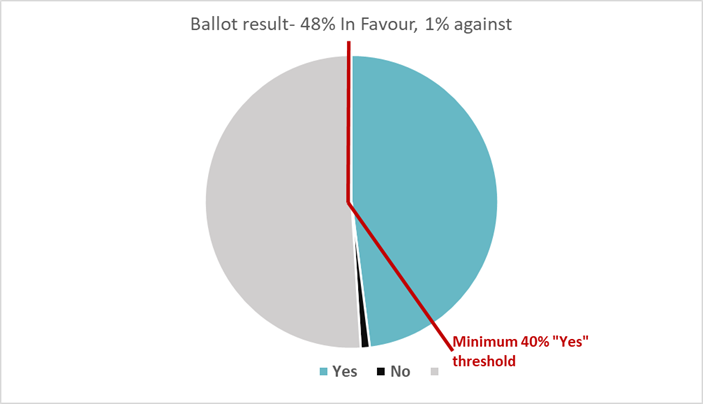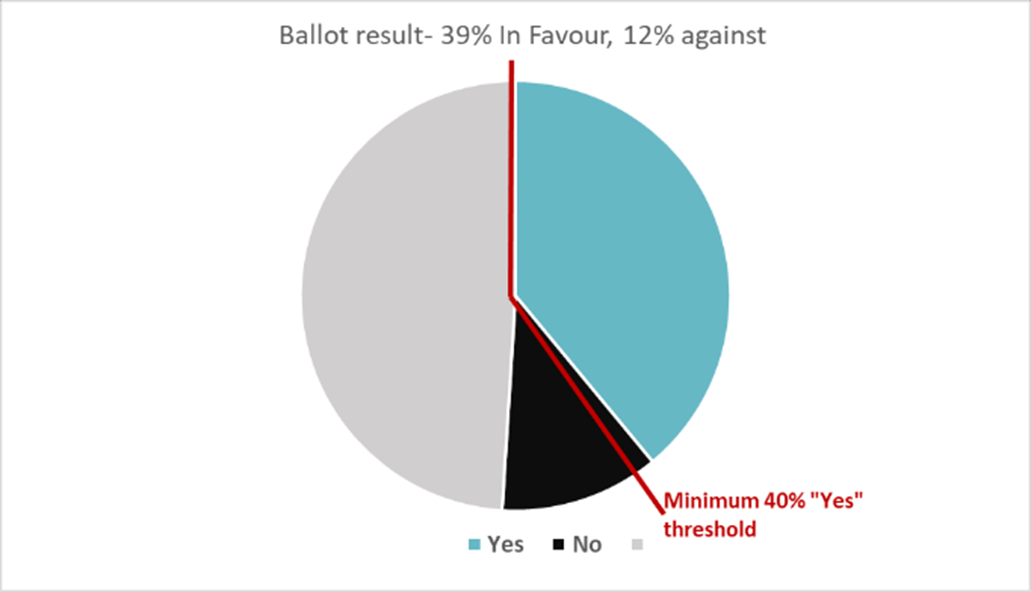As numerous instances of national and local industrial action fill media headlines, with mentions of a national strike as the cost of living crisis continues to have an impact on the country, the PDA is providing members with some FAQs regarding industrial action. The following six FAQs give PDA members an informative overview of why, how and when strikes may be called.
Q1 – What is a strike?
The terms ‘strike’ and ‘industrial action’ are often used interchangeably. There are actually three main forms of industrial action, with the term ‘strike’ used to describe the first two. This is where the workers act as a result of a dispute with their employer, usually about pay or terms and conditions.
- Strike – where workers refuse to work for the employer. This can be either continuous or discontinuous. Continuous means there is no set date on which the strike action ends so it continues until the dispute is settled. Discontinuous action usually means one or more separate days of strike action.
- Action short of a strike – where workers take action such as working to rule, go-slows, overtime bans, or callout bans.
- Lock-out – where the employer creates a work stoppage to prevent workers from working during a dispute.
Industrial action is a very serious step that both sides in a dispute should be attempting to avoid at all times. For workers, taking part in a strike means they will experience reduced income as they do not get paid for the time they are on strike. For the employers, industrial action may have consequences on their ability to run their finances, which could have longer term consequences, such as loss of reputation, contracts, or customers. The damage brought about by a strike could have longer term consequences for the organisation overall.
However, in a workplace that has union recognition, if a dispute between employees and employers cannot otherwise be resolved, it cannot be left for employers to be able to treat employees however they like, without consequence. The ultimate option for workers is to withdraw their labour. The right to do so falls under the protection of Article 11 of the European Convention on Human Rights and the International Labour Organisation’s Convention 87 on Freedom of Association and the Protection of the Right to Organise.
Q2 – Who can strike/take industrial action?
Workers can go on strike following an unresolved dispute between them and their employer(s). For PDA members, this means employed pharmacists that have a dispute with their particular employer(s).
Occasionally, you may read in the media about pharmacy owners going on strike because they are unhappy with the contract they have with the NHS. That is a misuse of the term as the two parties are not employees/employers with an industrial dispute. They are actually clients/suppliers with a different type of contractual dispute.
Similarly, although we sometimes refer generically to those that both employ pharmacists and engage locum pharmacists as ‘the employers’, in fact locums are not employees. Locums are ‘suppliers of pharmacist services’, and the pharmacy businesses they work for are their ‘clients’, not actually their employer.
Q3 – Who decides to call a strike?
PDA Union members democratically elect the union’s governing body, the National Executive Committee (NEC) and it is the NEC that decides when to formally ballot any group of members on the question of taking strike action.
It is then for the members employed at the relevant employer(s), and those members only, to vote as to whether or not they wish to take action.
The results of such ballots are reported to the NEC.
If the ballot outcome is a lawful ‘yes’ vote for industrial action, then the NEC will decide if and when to schedule any action.
Q4 – How do you call a strike ballot?
Strike regulations in the UK are complex with detailed regulations introduced by various governments over many years. There are detailed rules on how a union can call a strike, including on the ballot process, which must be held by postal voting.
In essence, a trade union must hold a lawful ballot of its members that are employed at that particular employer(s) before holding a strike. For a legitimate strike:
- At least 50% of the workers eligible to vote must participate,
- A simple majority of voters in favour of strike action must be secured.
Since 2016, there is an additional threshold to meet if the workers considering a strike provide an ‘important public service’. This would normally apply to pharmacists:
- At least 40% of those voting must vote in favour of the action.
Examples:

Fig 1: 25% in favour, 40% against. This would be a ‘no’ vote because the majority voted ‘no’.

Fig 2: 48% in favour, 1% against. This would be a ‘no’ vote because less than 50% of those eligible to vote took part.

Fig 3: 39% in favour, 12% against. This would be a ‘no’ vote if the workers provide an important public service (like most pharmacists do) because less than 40% of the union members voted in favour.

Fig 4: 70% in favour, 5% against. This would be a ‘yes’ vote. More than 50% of members took part in the ballot, the majority voted ‘yes’, and those who voted yes were more than 40% of those eligible to vote.
Any collective action by groups of employees that does not follow the correct legal process, sometimes called ‘wildcat’ action, is not a lawful strike and could leave the individuals and union involved subject to legal challenges.
Q5 – When are strike ballots held?
Postal votes are an expensive and time-consuming process, so trade unions try to only hold such ballots when they believe a ‘yes’ vote is likely. Sometimes the union may conduct indicative online ballots of members in advance of any formal postal ballot to assess the strength of feeling.
The impact of strike action by a smaller percentage of workers or a less motivated group of workers may not be enough to influence the employer to change their position, and failure to reach the 50% participation and 40% in favour thresholds would also mean the ballot fails to progress the dispute.
A ballot that ends in a ‘no’ vote outcome or an action that is not supported in practice by union members is unlikely to make the employer(s) change their position. The union’s NECs will therefore consider:
- What is the density (proportion) of union membership at that employer?
- What proportion of members engage in any surveys and/or meetings about the dispute?
- What percentage of members are indicatively for/against/undecided about strike action?
- How strong is the strength of feeling of members about the dispute?
- What is the impact of losing/winning the dispute?
A workplace with high union membership density, high member engagement, and a clear majority of members motivated to take action on an issue that could otherwise fundamentally change their employment for the worse is more likely to deliver a positive ballot result and to follow up with unified action that will have impact.
Q6 – Do health unions strike?
Yes, health unions and general unions that include workers within the health sector can and do strike. The decision to strike is for those union members employed by the particular employer(s) and those that are health professionals will balance their duty to patients with their attitude to strike action. For example, the Royal College of Midwives had existed for more than a century before it first took part in a strike in 2014.
It is usual for strikes, or action short of strike, that involve healthcare professionals to be organised in ways that do not compromise patient care. This approach can often be important to the success of the strike action.
The PDA Union was formed in 2008 and the circumstances of a strike ballot have not yet occurred, however it is, of course, always a possibility for any unresolved dispute. The closest that the PDA Union has been towards strike action so far was the Boots pay negotiations in 2021, when a special meeting of the union’s NEC considered holding a strike ballot. Ultimately, the majority decision of that meeting was not to ballot for strike action on that occasion.
More recently, a majority of PDA members employed by the NHS in England, Wales, and Northern Ireland that responded to an indicative ballot have told us they reject the proposed pay settlement, and would vote yes to industrial action if other unions are also striking.
Q7: What is a strike fund, and does the PDA Union have a strike fund?
An employer is entitled to withhold payment for each day of strike action, therefore an employee will usually give up a day’s pay for each day they strike. Some unions may have built up strike funds through their members donating money over previous years to a ringfenced fund reserved for that purpose. A strike fund can then provide financial support to members who take strike action, to lessen the financial impact on them as individuals. The PDA has never asked members to donate to a strike fund and so there is no such fund for any strike of PDA members, at this time
ACT NOW – What PDA MEMBERs need to do
Strike action is a possibility for any workers, including pharmacists. Therefore, PDA members should:
- Understand why, how, and when strikes are called.
- Ensure their MyPDA record accurately details who their employer is, so that they are correctly included in any indicative or formal ballot.
- Recruit colleagues into the union to strengthen the density of union membership at their employer.
- Consider how they will respond if you encounter a picket line. For more information on what to do when faced with an industrial action picket line, click here.
Learn more
- PDA Union members in England, Wales, and Northern Ireland reject the NHS pay award
- 2021 Boots pay negotiations
- Royal College of Midwives strike
- Update your MyPDA record
- Why join the PDA?
Not yet a PDA member?
If you have not yet joined the PDA, we encourage you to join today and ask your colleagues to do the same.
Membership is FREE to pharmacy students, trainee pharmacists, and for the first three months of being newly qualified.
Read about our key member benefits here.